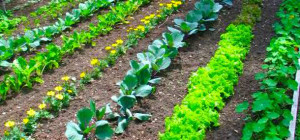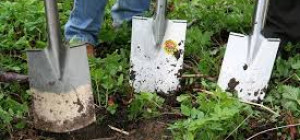 You sit on your porch on a warm, summer day. You close your eyes and feel the breeze playfully tickle your eyelashes. With your eyes shut, you envision the beauty of your garden. Bright yellow daffodils lean jauntily against deep red tulips. Wonderfully fragrant roses climb towards the heavens on white lattice. Shockingly bright green sprigs of fresh mint burgeon along the edges. It's so serene, so calming, and so perfect. Then you open your eyes and realize you've been daydreaming. The only things growing in your backyard are a few scruffy looking bushes and the odd weed or two boldly daring you to uproot them. No need to get discouraged—your daydream could easily become a reality. With careful planning and some hard work, you can transform your backyard into the tranquil garden of your fantasies.
You sit on your porch on a warm, summer day. You close your eyes and feel the breeze playfully tickle your eyelashes. With your eyes shut, you envision the beauty of your garden. Bright yellow daffodils lean jauntily against deep red tulips. Wonderfully fragrant roses climb towards the heavens on white lattice. Shockingly bright green sprigs of fresh mint burgeon along the edges. It's so serene, so calming, and so perfect. Then you open your eyes and realize you've been daydreaming. The only things growing in your backyard are a few scruffy looking bushes and the odd weed or two boldly daring you to uproot them. No need to get discouraged—your daydream could easily become a reality. With careful planning and some hard work, you can transform your backyard into the tranquil garden of your fantasies.
1. Settle on a Vision
Before you can begin your garden in earnest, you must have a clear vision of what you want to create. What is the primary purpose of your garden? Is it to entertain? To look pretty, or grow food? To provide a relaxing haven? To improve your bird watching? Take the time to sit down and write out exactly what your gardening goals are. This will give your garden project focus and motivation.
2. Find an Ideal Spot
Just because you think a garden will look great in a particular corner of your yard, doesn't necessarily mean that plants would actually thrive there. There are a lot of things you need to take into consideration when choosing the future location of your garden such as sun exposure, water access, obstructive objects, and soil quality.
You should select a spot where there is ample sun exposure and easy access to a water source to ensure that your plants flourish. Obstructive objects could be anything from large rocks embedded in the soil to tree roots lurking just beneath the surface. You'll want to plant in an area free of such obstacles. Unless you are secretly an expert in soil composition, you should have your soil tested at a local Cooperative Extension to determine whether it is lacking any nutrients essential for plant life or harboring toxins that will harm your garden.
3. Select Plants
Once you've selected the perfect location and are aware of the quality of soil you're working with, it's time to select your plants. The staff of a local plant nursery should be able to provide you with information about the hardiness of particular varieties and help you find ideal matches for your garden. Make sure you also ask how much maintenance each type requires. This is really important if you don't have time to be puttering around in the garden every single day. And always avoid buying plants that seem dull, limp, or unhealthy; you want only the strongest and healthiest plants to start your garden off right.
4. Design It
Now it's time to let your creative juices flow. If you're having difficulty finding inspiration, it can be helpful to design your garden around a specific theme such as a single color or a particular group of plants. There are also computer programs that can aid your design process like Garden Planner. These programs allow you to create a 3D layout of your garden by moving around trees, shrubs, plants, and other objects to mirror your vision. You can also add wonderful garden accents such as a gazebo or a garden bridge.
5. Make It Happen
You've identified a location, purchased your plants, and settled on a design—the only thing left is to put your well-laid plans into action. You'll need to invest in a few essential gardening tools like pruners, gloves, and trowels. It's wise to purchase high quality gardening gear since they will endure a lot of wear and tear.
6. Maintain It
The work isn't done when the garden is planted. Successful gardening requires consistent maintenance in order to thrive. You'll need to tend to your new garden regularly by pruning, planting, watering, fertilizing, and weeding. Gardens entail constant work, but once you get a feel for the seasonal rhythm of your plants and see how your labors are rewarded with vibrancy, you may find there's no place you'd rather be than in your garden.
Written by Mark Winkelman. Mark is a Project Advisor at Fifthroom.com. Fifthroom.com allows you to create an outdoor space that brings together the intricate splendor of nature and the comforts of modern convenience.







